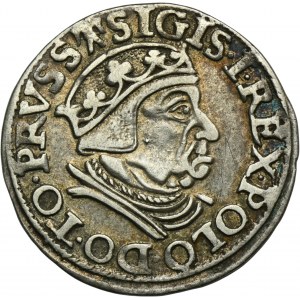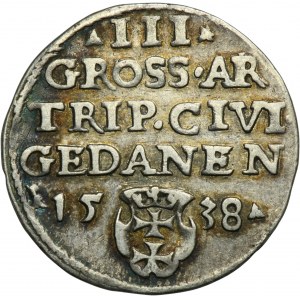Variety with PRVSS inscription ending. Punctuation in the form of dots on obverse and reverse.
Scratch on the obverse.
Well-preserved detail. Fragments of gloss.
During the reign of Sigismund the Old, in 1526-1528, perhaps the most important monetary reform in the history of Polish money was carried out. A modern, well-functioning system based on full value coinage - silver and gold - was introduced. The monetary system of Sigismund the Old was represented by denars, ternars, shekels, half-pennies, groszy, troyaks, sixpences, thalers (still medals) and ducats. The king led to the monetary union of the Crown and Royal Prussia. However, the monetary system of the Grand Duchy of Lithuania functioned separately (4 Lithuanian pennies equaled 5 Polish pennies). Sigismund the Old left his mark not only on Polish minting (as King of Poland) and on Lithuanian minting (as Grand Duke of Lithuania). He also left his mark in Silesian minting as the Duke of Glogow, minting (possibly) halers and (certainly) Glogow groszes in 1505 and 1506.
In the history of Polish minting, trojaki first appeared during the reign of Sigismund the Old. The first trojaks were issued by the Crown Mint in Cracow in 1528. They were minted from rather weak, VI-gold silver, obtained from Świdnica half-pennies pulled from the market. The average weight of the coin was 6.177 grams, while the pure silver content was 2.316 grams. Crown trojaks were minted only in 1528, in two types: portrait/eagle to the right and portrait/eagle to the left. In addition to crown trojaks, Prussian (Torun) and city (Gdansk, Elblag) trojaks were also issued during the time of Sigismund the Old. Prussian trojaks were minted from good 14th-century silver, weighed 2,671 grams and contained 2,337 grams of pure bullion. Danzig trojaks were minted to the same standard. Like Prussian trojaks, they had a portrait of the king and an ombre inscription on the obverse and a zonal inscription and - in addition - the city coat of arms on the reverse. Elbląg trojaks were minted according to the same rate as in Toruń and Gdańsk. However, they had a different iconographic scheme: on the obverse the zonal inscription, and on the reverse the city coat of arms and the otolith inscription.









